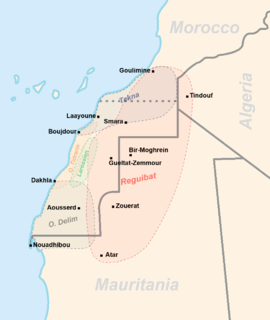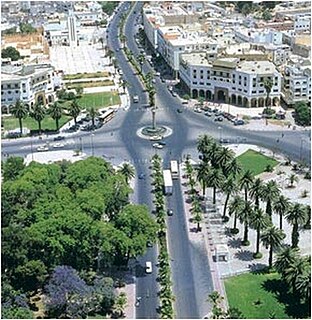
Cape Juby is a cape on the coast of southern Morocco, near the border with Western Sahara, directly east of the Canary Islands.

The Tijāniyyah is a Sufi tariqa, originating in the Maghreb but now more widespread in West Africa, particularly in Senegal, The Gambia, Mauritania, Mali, Guinea, Niger, Chad, Ghana, Northern and South-western Nigeria and some part of Sudan. The Tijāniyyah order is also present in the state of Kerala in India. Its adherents are called Tijānī. Tijānī place great importance on culture and education, and emphasize the individual adhesion of the disciple (murid). To become a member of the order, one must receive the Tijānī wird, or a sequence of holy phrases to be repeated twice daily, from a muqaddam, or representative of the order.

The Sahrawi, or Saharawi people, are an ethnic group and nation native to the western part of the Sahara desert, which includes the Western Sahara, southern Morocco, much of Mauritania, and the extreme southwest of Algeria.

Spanish Sahara, officially the Spanish Possessions in the Sahara from 1884 to 1958 then Province of the Sahara between 1958 and 1976, was the name used for the modern territory of Western Sahara when it was occupied and ruled by Spain between 1884 and 1976. It had been one of the most recent acquisitions of, as well as one of the last remaining holdings of the Spanish Empire, which had once extended from the Americas to the Spanish East Indies.

The Southern Provinces or Moroccan Sahara are the terms used by the Moroccan government for Western Sahara. These two Moroccan terms explicitly include all of Western Sahara, which spans three of the country's 12 top-level administrative regions. A frequent use of the term "Southern Provinces" is found for example in Moroccan state television.

Settat is a city in Morocco between the national capital Rabat and Marrakesh. Settat is located 83.9 km by road south of the centre of Casablanca, roughly an hour's drive. It is the capital of Settat Province and is its largest city in both size and population. According to the 2014 Moroccan census, it had a population of 142,250 people, up from 116,570 people in the 2004 census. Settat is 370m above sea level, built on a plateau surrounded by foothills in all directions. The antiquities of Settat include the very old Ismailiya Kasbah distinguished by the statue of a steed which lies at the center of the city.
The Oulad Bou Sbaa is a Chorfa/Zaouia tribe, who claim descent from Abu Sib'a, the Idrissid 16th century tribal chief. They live in Morocco, Western Sahara and Mauritania, with members of the tribe holding different nationalities depending on their residence and upbringing. In the 19th and 20th century, the tribe's influence in its core areas of southern Spanish Sahara was diminished and permanently weakened following defeat in bloody battles against the Reguibat tribal confederations, which were then rapidly asserting their influence over these areas. Speakers of Hassaniya Arabic, they were nomadic (Bedouin), and herded camels in today's Western Sahara and Mauritania.

The Reguibat is a Sahrawi tribe of Arab origins, founded by the Islamic leader Sidi Ahmed Reguibi.The Reguibat speak Hassaniya Arabic. They are descended from Sidi Ahmed Rguibi, who lived in the Saguia el-Hamra region in the 16th century. They are a chorfa tribe, i.e. descendants of Muhammad. Religiously, they belong to the Maliki school of Sunni Islam.
Mzab is a confederation of tribes in the Chaouia plain south of Casablanca in Morocco. The bulk of Mzab are Bedouin Arab tribes, while the rest are of Hilalian Arab origins. The Moroccan Mzab are not to be confused with the Algerian Berber tribe that has the same name. Mzab is Arabic for the Mozabite people.

Doukkala-Abda was formerly one of the sixteen regions of Morocco from 1997 to 2015. It is situated in west-central Morocco. It covered an area of 13,285 km² and had a population of 2,173,090. The capital is Safi.
Sidi Ahmed al-Rgibi was a Arab Sahrawi Islamic preacher and political leader from Beni Hassan tribe, in the tribal areas of the north-western Sahara desert in the 16th century. He was born in 1590 in El Kharaouiaa. He was considered a holy man and an idrissid, or descendant of Muhammad. He died at the age of 75.
Banu Khutheer of Al Hajaj Tribes are a clan that originally goes back to their ancestor Hashid, who in turn comes from the house of Himdaan. And Himdaan, the Great Great Ancestor of the Hajaj Tribes accepted Islam from Ali bin Abi Taleb.
Harrak refers to the last name carried by the Northern Moroccan families that claim descent from the sons of Al-Harrak; one of the direct descendants of the Islamic prophet, Muhammad, through Ali ibn Abu Talib and Fatimah.abdelhamid El harrak

Béni Abbès, also known as the Pearl of the Saoura, and also as the White Oasis, is a town and commune located in western Algeria in Béchar Province, 241 km (150 mi) far from the provincial capital Béchar, and 1,200 km (746 mi) from Algiers.
PrincessLalla Khanatha bint Bakkar also known as Hinata binti Bakar al-Gul, was de facto ruler of Morocco from 1729 to ca. 1754. She was one of the four wives of Sultan Moulay Ismail, and acted as his de facto First Minister and Secretary. After his death, she remained a de facto ruler during the unstable situation which followed as the mother of Sultan Moulay Abdallah.

Iznasen berber or Taznast is a Zenati dialect of the tribe At Iznasen, established in the north-east of Morocco in the Berkane province and the north of Oujda province.

Laâyoune-Sakia El Hamra is one of the twelve regions of Morocco. It is mainly located in the disputed territory of Western Sahara: the western part of the region is administered by Morocco and the eastern part by the Sahrawi Arab Democratic Republic. The region as claimed by Morocco covers an area of 140,018 square kilometres (54,061 sq mi) and had a population of 367,758 as of the 2014 Moroccan census. The capital of the region is Laâyoune.

The Mauritania–Western Sahara border is 1,564 kilometres (972 mi) in length and runs from the tripoint with Algeria in the north-east to the Atlantic Ocean in the south-west.

The Seven Saints of Marrakesh or Patron Saints of Marrakesh are seven historical Muslim figures buried in Marrakesh, Morocco. Each of them was a famous Muslim judge, scholar or Sufi saint (wali) venerated for their piety or other mystical attributes. Their tombs form the basis of a centuries-old annual pilgrimage, a ziyara, during which visitors pray at each of their tombs over the course of seven days.













